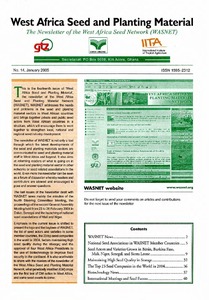| dc.contributor.author | Kanju, E. |
| dc.contributor.author | Mahungu, N.M. |
| dc.contributor.author | Whyte, J. |
| dc.contributor.author | Dixon, A. |
| dc.date.accessioned | 2019-12-04T11:24:14Z |
| dc.date.available | 2019-12-04T11:24:14Z |
| dc.date.issued | 2004 |
| dc.identifier.citation | Kanju, D.E., Mahungu, N.M., Whyte, J.A. & Dixon, A. (2004). Association between zigzag stem habit and resistance/tolerance to cassava brown streak virus disease. In: Proceedings of the 9th ISTRC-AB Symposium in Kenya: advances in root and tuber crops technologies for sustainable food security, improved nutrition, wealth creation and environmental conservation in Africa, 1-5 November, Mombasa, Kenya, (pp. 421-424). |
| dc.identifier.uri | https://hdl.handle.net/20.500.12478/4316 |
| dc.description.abstract | Cassava is an important food staple in the coastal provinces of east and southern Africa. However, its production is adversely affected by cassava brown streak virus disease (CBSD). CBSD first reported from Amani, Tanzania in 1936, is now considered to be one of the major biotic constraints to cassava production especially in the coastal lowlands. Efforts to develop resistant varieties as the major control measure for CBSD started way back in the 1940s. in efforts to improve breeding efficiency, some researchers have investigated the correlation between morphological traits and resistance to CBSD. The zigzag stem growth habit is one of the marker genes identified in cassava. Marker genes control the expression of traits which can be easily classified into distinct states, each controlled by a different allele, and whose expression is little influenced by the environment. There is evidence to suggest that a single recessive gene (zz) controls the expression of the zigzag stem trait. Field observations have now revealed that all the CBSD tolerant cultivars identified in Tanzania are heterozygous (Zz) for the zigzag stem trait. The varieties are: Kigema Mafia (or Kigoma Red), Nanchinyaya, Kiroba, TMS 30001, Namikonga, Kitumbua, Kalulu (or Kalolo). NDL 90/34 and Amani 46106/27. In Kenya, two cultivars, Kaleso (Amani 46106/27) and Kahoteli, which are tolerant to CBSD, are also heterozygotes. Furthermore, in Mozambique eight cultivars, Nikwaha, Mulaleia, Macia I. Likonde, MZ89001, MZ89186, (MM 30025 and Mocuba, which are tolerant to CBSD are heterozygotes. These observations imply that there is a strong possibility that the gene conferring tolerance to CBSD is linked to the “z” allele. So far, no genotype has been found which is both tolerant to CBSD and homozygous dominant for the stem trait (ZZ). However, further evidence is required to prove this association. Rapid genetic progress will be made in breeding for tolerance/resistance to CBSD if this association is proved. |
| dc.language.iso | en |
| dc.subject | Cassava |
| dc.subject | Food Production |
| dc.subject | Diseases |
| dc.subject | Plant Diseases |
| dc.title | Association between zigzag stem habit and resistance/tolerance to cassava brown streak virus disease |
| dc.type | Conference Paper |
| dc.type | Conference Paper |
| dc.description.version | Peer Review |
| cg.contributor.crp | Agriculture for Nutrition and Health |
| cg.contributor.crp | Roots, Tubers and Bananas |
| cg.contributor.affiliation | International Institute of Tropical Agriculture |
| cg.coverage.region | Africa |
| cg.coverage.region | East Africa |
| cg.coverage.country | Tanzania |
| cg.authorship.types | CGIAR single centre |
| cg.iitasubject | Cassava |
| cg.accessibilitystatus | Limited Access |
| local.dspaceid | 99882 |

